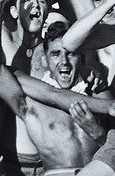ALBERTSEN-NORMAN
NORMAN ARTHUR "AL" ALBERTSEN

TM1/WO1

THE DAY OF LIBERATION FROM
JAPANESE POW CAMP OMORI
AUGUST 29, 1945
Camp Omori was on a man made island in Tokyo Bay and housed nearly 900 POWs by the end of World War II. Near the end of the war rumors were rampant as most of the prisoners speculated that when Americans got close, the guards would gather them and gun them down. By the summer of 1945 there was little doubt the Americans were now very close because of the intensity of nearby air strikes. Treatment at the camp was horrific as all able-bodied prisoners were made to work at nearby docks and warehouses. Beatings, sickness, and barely edible food led to the death of many of Omori’s prisoners.
Suddenly, on August 15, 1945, things drastically changed after the Japanese emperor announced the war was ending. Work details suddenly ceased, many of the guards abandoned their posts, and those who were left passed out clothes, vitamins, toilet paper, and more food than the startled captives had seen before. When American ships began to appear in Tokyo Bay on August 29, 1945, the prisoners were delirious with excitement as it seemed their death sentence had been lifted.
On August 29th the first American landing craft came close to Camp Omori as it was led by a torpedo bomber guiding it to the camp. As the landing craft approached, pandemonium broke out on the camp pier as prisoners rushed to the water’s edge. Approaching the pier, a Navy photographer snapped a picture and later wrote: “We finally spotted the moving figures on a pier jutting out to the bay. We came closer – they were screaming and yelling and waving their arms, their shirts, and an American flag. Some wore no clothing at all, some had G-strings, and others had on the remnants of what they were captured in, and a few had on new clothes that had been dropped by B-29s the last few days. Some started to swim for our boat and were told to go back. The others kept waving and shouting and we waved and shouted back, and tears came to my eyes.”
The photograph was widely published and historians have searched the famous photo to establish identities. Only thirteen have been named which includes eleven Americans (US Army Air Force-6; USN-4, USMC-1) one from Holland, and one from South Africa.
Torpedoman First Class Norman Arthur Albertsen was one of the joyful POWs in the photograph and has been named as one of the men who secretly helped in creating the U.S. flag. It was made on a stolen Japanese sheet using coloring supplies from Red Cross packages. The men knew they faced execution if the Japanese discovered the flag and were threatened with court martial by superiors who felt all prisoners would be punished if the flag was found.
TM1 Albertsen was a survivor of the submarine USS Grenadier which was lost April 22, 1943. The boat was on her sixth war patrol off the coast of Thailand in the Lem Voalan Strait when it was spotted on the surface by a Japanese plane. Bombs critically damaged the submarine which was purposely scuttled because it could no longer safely submerge. All 76 crewmembers were captured and TM1 Albertsen spent two and a half years at Camp Omori. Following his release, he remained in the Navy serving on submarines, submarine tenders, and destroyers before retiring in July 1959 with the rank of Warrant Officer First Class. He was next employed by the Navy at Point Mugu in California for another 20-years. He died April 19, 2010, in Carson City, Nevada.


Submitted by CDR Roy A. Mosteller, USNR (Ret)


